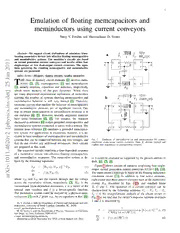
Emulation of floating memcapacitors and meminductors using current conveyors PDF
Preview Emulation of floating memcapacitors and meminductors using current conveyors
1 Emulation of floating memcapacitors and meminductors using current conveyors Yuriy V. Pershin and Massimiliano Di Ventra Abstract—We suggest circuit realizations of emulators trans- aa L[[t]]= formingmemristivedevicesintoeffectivefloatingmemcapacitive V1 = V2 RRM [t]C 1 and meminductive systems. The emulator’s circuits are based 1 on second generation current conveyors and involve either four Y X X Y 0 single-output or two dual-output current conveyors. The equa- V11 ZZ R ZZ V22 2 tions governing the resulting memcapactive and meminductive systems are presented. CC n a Index Terms—Memory, Analog circuits, Analog memories. J THE class of memory circuit elements [1] involves mem- ZZ YY 5 ristors [2], [3], memcapacitors [1] and meminductors Y X X Z 2 [1], namely resistors, capacitors and inductors, respectively, R M ] which retain memory of the past dynamics. While there t are many discovered experimental realizations of memristive e CC[[tt]]= d systems, the number of systems showing memcapacitive and b V V L/(RR [t]) - meminductive behavior is still very limited [1]. Therefore, 1 = 2 M s RR M n electroniccircuitsthatemulatethebehaviorofmemcapacitive Y X X Y s.i awnadymtoeombitnadinucmtiveemcealepmaceintitvseaorremoefmsiingdnuificctiavnetrienstpeorensste. iOsntoe VV1 Z Z VV2 c i use mutators [4], [5]. However, recently suggested mutators LL s have some limitations [4], [5]. For instance, the mutators y h discussedinreference[4]realizegroundedmemcapacitiveand Z Y p meminductivesystemsconnectedinserieswitharesistor.The [ mutator from reference [5] simulates a grounded memcapaci- YY XX XX ZZ R 2 tive system. For applications in electronics, however, it is de- v sirabletohaveemulatorsofmemcapacitiveandmeminductive 0 systems that can be connected between any two voltages, and Fig. 1. Emulators of meminductive (a) and memcapacitive (b) systems 2 employing single-output current conveyors. Here, [t] denotes implicit and that do not involve any additional resistances. Such circuits 6 explicittimedependenceofcorrespondingelements. are proposed in this work. 4 . Thesuggestedcircuitstransformatime-dependentresponse 1 of a memristive system into effective floating memcapacitive 1 0 and meminductive responses. The memristive system is de- or it could be emulated as suggested by the present authors in 1 fined by the following equations: Refs. [4], [7], [8]. : v I = [R (x,V ,t)]−1V , (1) Figure 1 shows circuits of mutators employing four single- i M M M M output second generation current conveyors (CCII+) [9], [10]. X dx = f(x,V ,t), (2) Themaincircuit’stopologyisbasedonthefloatinginductance r dt M a simulation circuit [11]. In addition to four active elements, where IM and VM are the current through and the voltage eachcircuitusesthreepassiveelementssuchasthememristive across the memristive system, respectively [3], RM is the system RM described by Eqs. (1-2), and standard linear memristance (time-dependent resistance), x is a vector of the R, C and L. The operation of a current conveyor can be internal state variables and f is a device-specific function. characterized by the following relations: V = V , I = I , x y x z The memristive system could be realized by a physical mate- I = 0. By straightforward analysis of the circuit shown in y rial/system[1](withf given,e.g.,bytheequationsinRef.[6]) Fig. 1(a) we find that the circuit’s response between terminals 1 and 2 is described by Yu.V.PershiniswiththeDepartmentofPhysicsandAstronomyandUSC Nanocenter,UniversityofSouthCarolina,Columbia,SC,29208 e-mail:[email protected]. I = 1 φ≡[L(x,φ,t)]−1φ, (3) M.DiVentraiswiththeDepartmentofPhysics,UniversityofCalifornia, CRR (x,φ/(RC),t) SanDiego,LaJolla,California92093-0319 M e-mail:[email protected]. dx = f(x,φ/(RC),t) (4) ManuscriptreceivedNovemberXX,2010;revisedJanuaryYY,2011. dt 2 L[[t]]= same as Eqs. (3-4) and Eqs. (5-6), respectively. aa V1 = V2 RRM [t]C In conclusion, we have presented emulators of floating memcapacitive and meminductive systems using second gen- Y Z- eration current conveyors involving either four single-output VV11 X Z YY ZZ- or two dual-output current conveyors. The resulting circuits mutate memristive system’s dynamics into an effective mem- X Z capacitive and meminductive response. Since memristor emu- V C 2 lators can be easily made from off-the-shelf components [7], R RR MM [8], [4], we expect these mutators to find widespread use in electronic applications with memdevices. REFERENCES CC[[tt]]= [1] M. Di Ventra, Y. V. Pershin, and L. O. Chua, “Circuit elements with b memory:Memristors,memcapacitors,andmeminductors,”Proc.IEEE, V1 = V2 L/(RRM [t]) vol.97,no.10,pp.1717–1724,2009. [2] L. O. Chua, “Memristor - the missing circuit element,” IEEE Trans. Y Z- CircuitTheory,vol.18,pp.507–519,1971. [3] L.O.ChuaandS.M.Kang,“Memristivedevicesandsystems,”Proc. VV 11 X Z YY ZZ- IEEE,vol.64,pp.209–223,1976. [4] Y.V.PershinandM.DiVentra,“Memristivecircuitssimulatememca- X Z pacitorsandmeminductors,”ElectronicsLetters,vol.46,pp.517–518, L V2 2010. RM R [5] D. Biolek and V. Biolkova, “Mutator for transforming memristor into memcapacitor,”El.Lett.,vol.46,p.1428,2010. [6] Y.V.Pershin,S.LaFontaine,andM.DiVentra,“Memristivemodelof amoebalearning,”Phys.Rev.E,vol.80,p.021926,2009. [7] Y. V. Pershin and M. Di Ventra, “Practical approach to programmable analogcircuitswithmemristors,”IEEETrans.Circ.Syst.I,vol.57,p. 1857,2010. Fig. 2. Emulators of meminductive (a) and memcapacitive (b) systems [8] ——, “Experimental demonstration of associative memory with mem- employingdual-outputcurrentconveyors.Thedual-outputcurrentconveyors ristiveneuralnetworks,”NeuralNetworks,vol.23,p.881,2010. satisfytherules:Vx=Vy,Ix=Iz,Iy =0,andIz−=−Iz. [9] A.SedraandK.Smith,“Asecond-generationcurrentconveyorandits applications,”IEEETrans.Circ.Th.,vol.CT17,p.132,1970. [10] B.Wilson,“Recentdevelopmentsincurrentconveyorsandcurrent-mode circuits,”IEEProc.G,vol.137,pp.63–77,1990. where the flux φ is given by φ(t) = (cid:82)t(V1(t(cid:48))−V2(t(cid:48)))dt(cid:48). [11] Won.cKuirrraennotncoannvdePy.oPrsa,w”aErlaencgtrkoonoincs,“LFeltoteartsin,gvoinl.d3u3c,tapnpc.e1s7i4m8u–l1a7ti4o9n,b1a9s9e7d. 0 [12] K.Pal,“Modifiedcurrentconveyorsandtheirapplications,”Microelec- The analysis of the circuit presented in Fig. 1(b) results in the tronicsJournal,vol.20,p.37,1989. following system’s equations: [13] A. M. Soliman, “Current conveyor filters: Classification and review,” MicroelectronicsJournal,vol.29,pp.133–149,1998. L [14] W.TangsriratandW.Surakampontorn,“Highoutputimpedancecurrent- Q = RR (x,(V −V ),t)(V1−V2)≡ modeuniversalfilteremployingdual-outputcurrent-controlledconvey- M 1 2 orsandgroundedcapacitors,”AEU-InternationalJournalofElectronics ≡ C(x,(V −V ),t)(V −V ), (5) andCommunications,vol.61,pp.127–131,2007. 1 2 1 2 dx = f(x,(V −V ),t). (6) dt 1 2 It is readily seen that Eqs. (3-4) and (5-6) describe float- ing flux-controlled meminductive systems [1] and voltage- controlled memcapacitive systems [1], respectively. If we consider equation (3) and algebraically solve it with respect to the flux φ (assuming a unique solution at any given time), we can then substitute the result into (4) and obtain equations of a current-controlled meminductive system. The same can be done for Eqs. (5) and (6) thus transforming a voltage- controlledmemcapacitivesystemintoacharge-controlledone, providedauniquesolutionofEq.(5)existsatanygiventime. Itwaspreviouslydemonstratedthatdual-outputcurrentcon- veyorscanbeusedtoreducethenumberofactivecomponents indifferentcircuits[12],[13],[14].Fig.2representsemulators of meminductive and memcapacitive systems based on a floating-inductor simulation circuit [12]. Each of the circuits in fig. 2 employs one memory element (memristor), two other passive and two active elements. The equations governing the effective meminductive and memcapacitive behaviors are the
